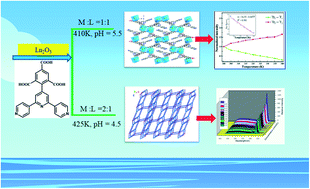In situ ligand-induced Ln-MOFs based on a chromophore moiety: white light emission and turn-on detection of trace antibiotics†
Abstract
A series of four novel 3-D Ln-MOFs containing both carboxyphenyl and pyridinyl moieties, with the general formula [Ln2(tcptp)(btca)(H2O)m]n {Ln = Sm3+(1), m = 13; Eu3+(2), m = 12; Gd3+(3) m = 13 and Tb3+(4), m = 14; H3tcptp = 4-(2,4,6-tricarboxyl phenyl)-4,2′:6′,4′′-terpyridine}, have been constructed. During reaction, benzene-1,2,3,5-tetracarboxylic acid (H4btca) was generated in situ as a second linker, resulting in the formation of a 3D framework, bearing 1D elliptical channels. MOF-1 exhibits dual emissions based on the ligand and Sm3+, through which single-component complementary near-white-light emission was realized. Both MOF-2 and MOF-4 display strong ligand–metal charge transfer (LMCT) emissions due to an antenna effect. Remarkably, for MOF-4, Tb3+-based fluorescence turn-on sensing of levofloxacin in solution with high sensitivity and excellent selectivity was achieved through a donor photoinduced electron transfer (d-PET) approach, which distinguishes it from other antibiotics, meaning that MOF-4 can be employed as a promising specific fluorescence sensor.

- This article is part of the themed collection: CrystEngComm up-and-coming articles


 Please wait while we load your content...
Please wait while we load your content...